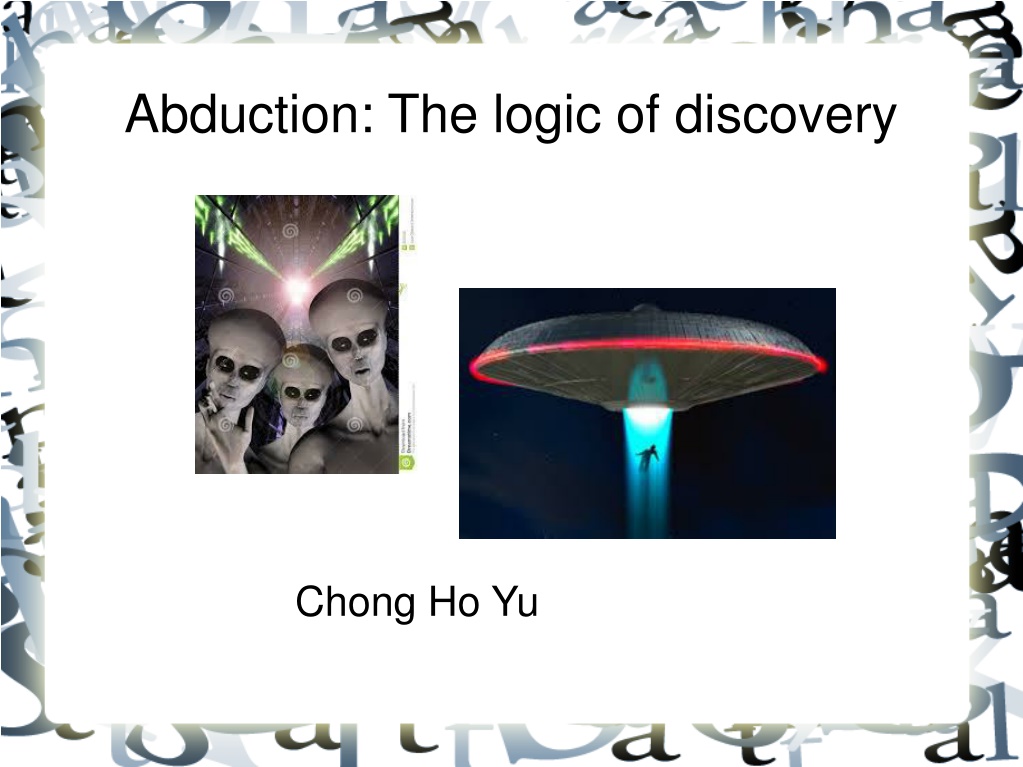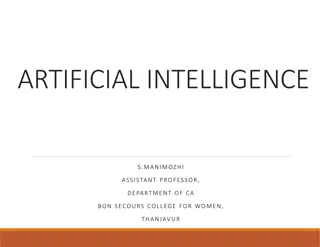Understanding Logic in Research: Abduction, Deduction, and Induction
Explore the fundamental concepts of logic in research including abduction, deduction, and induction. Learn about hypothesis testing, material implication, and the relationship between theory and data. Gain insights into how knowledge is generated through accumulating data and the self-correcting process of inquiry.
Download Presentation

Please find below an Image/Link to download the presentation.
The content on the website is provided AS IS for your information and personal use only. It may not be sold, licensed, or shared on other websites without obtaining consent from the author. Download presentation by click this link. If you encounter any issues during the download, it is possible that the publisher has removed the file from their server.
E N D
Presentation Transcript
Abduction: The logic of discovery Chong Ho Yu
Deduction Hypothesis testing is said to be a hypothetico- deductive method. All observed statistics beyond the .05 cutoff are significant (True). This observed statistic is beyond the .05 cutoff (True). Significant; reject the null hypothesis (True).
Deduction All observed statistics beyond the 0.05 cutoff are significant (True). This observed statistic is not beyond the .05 cutoff (False). Not significant; not to reject the null hypothesis (False). Test a single theory or hypothesis; yes or no, let me go.
Deduction What will a researcher conclude if neither the proposition all observed statistics beyond the 0.05 cutoff are significant nor the statement this observed statistic is beyond the .05 cutoff is true?
False, False, True! If Congress passes serious campaign finance reform, then I am the Pope! The sentences are false, but following the rule of material implication, two false antecedents create a true conditional (F ^ F -> T)!
Phenomenon and data Hypotheico-deductive method deals with the relationship between the theory and the data, not the phenomenon (Haig) Phenomena are relatively stable and keeps recurring. Data are fleeting. Good model fitness between the theory and the data at hand assuming the recurring data are stable, but indeed they are not!!!
Example from Test and Measurement Flynn effect is a phenomenon. IQ scores have been rising from generation to generation. Data are changing. If we look at data in isolation, we will be missing the phenomenon.
Induction Knowledge is generated from accumulating data and inquiry is a self-correcting process. Logical positivism: There is only empirical knowledge (driven by observable data). Based on reasoning with long run: Assume that the future would resemble the past. However, regression entails the tendency of falling back to the mean)
What's wrong? An alien civilization visited our planet and collected data about our physical growth. They observed our children (from 1-10 years old) and constructed a regression model of their age and height. The aliens conclude that human is a dangerous species that will threaten them. What s wrong with their regression model?
What's wrong? In the 1980s many experts predict that by the end of the 20thcentury Japan would overtake the US to become the world s largest economy. Today many experts make similar predictions about China. What is the shortcoming of this predictive model?
Black swan vs. elephant in the room The book entitled "The Signal and the Noise" by Nate Silver also used the collapse of Japan in the early 1990s as an example. The bloom of Japan in the 1980s was unrealistic because the real estate price could not go up forever. Before 2008 the majority of the US experts could not predict a crash like that of Japan would happen in the US. But Silver asserted that the 2008 crash is not a Black Swan; rather, it is an elephant in the room.
Is there always a long run? In the Fisherian tradition, probability is defined in the long run, which is comparable to inductive reasoning. P = how likely you can observe the statistics in the long run? A new phenomenon or an unrepeatable event may not have a corresponding probabilistic distribution in the Fisherian sense, let alone a null hypothesis, an alternate hypothesis, and a Type I error rate.
Abduction Introduced by Charles Pierce. The surprising phenomenon, X, is observed. Among hypotheses A, B, and C, A is capable of explaining X. Hence, there is a reason to pursue A
Abduction Unlike hypothesis testing that starts with a strong theory, it starts with the phenomenon. P(H|D), not P(D|H) A subtle difference between phenomenon and data-- Phenomenon: Stable; Data: varying. It takes multiple plausible explanations into account, not just testing a single theory or hypothesis.
Abduction At most, abduction could provide a conjecture or a potential hypothesis A to pursue, but it would not confirm or disconfirm A Inference to the best explanation (IBE): similar to abduction, modified by Harmon. After inquiry, we found multiple competing theories that can explain the phenomenon. Pick the best one! Criterion: most explanatory power
IBE: Pick the best! It is like that you interviewed ten girls selected from e-harmony or Christian Mingle, and then you pick the best one to be your bride.
Example of abduction Yu, C. H. & Wu, S. F. (2014, October). Teaching math and science as a value system: Lessons from Asia. Paper accepted for Asian Conference in Education, Osaka, Japan. A puzzling phenomenon: According to PISA and TIMSS, East Asian students outperform their US counterparts in math, science, and reading.
Mixed method Sequential Exploratory Design When the problem is ill-defined and the variables are unknown, the researcher could employ qualitative methods to understand the problem rather than imposing a theory on the phenomenon. This design is particularly useful when the researcher needs to develop an instrument to collect data, but is not sure about what constructs should be measured and what questions should be asked.
Mixed Method Yu spent five weeks in Hong Kong, Macau, and Taiwan, talking to professor, teachers, parents, and school children, and also submersing himself into the cultures.
Mixed Method The resulting is surprising: Instead of framing the research question as because of, Yu changed the question as in spite of and regardless of. In the second phase quantitative design will be employed to study the proposed theory.
Example of IBE Yu, C. H., Hui, C. H., Lau, Y. Y., & Cheung, S. F. (2014, April). A typology of Christian believers according to the values they hold. Paper presented at the 12th Annual Mid-Year Conference on Religion and Spirituality, La Mirada, CA. Two-step clustering analysis is used to classify Christians into two groups: personal-focused and social-focused.
Example of IBE The grouping factor can predict their religious behaviors.
Multiple competing theories Do Christians read more Christian books, support mission works, and do other religious things because their values are more social-focused, or have they become social-focused in their values because their religious behaviors shaped their personal values? Another possibility is that personal values and religious behaviors are in a positive feedback loop, being both cause and effect at the same time.
Mixed method Sequential explanatory design Utilizing the insight gained from qualitative data to explain significant (or non-significant) results, outliers, or puzzling findings yielded from quantitative data. The p values and other numbers cannot give you a causal explanation. You need to interview the participants.
Example of abduction in assessment Instead of using a top-down approach (blue print), go to the bottom (what outcome do you want to see?) Reverse engineering or converse reasoning: What concept is required to successfully deliver the product? Which cognitive component is missing if the result is not desirable? What is the required concept just one step before the previous component?
Example of abduction in assessment The content expert may explain, A Maglev, which stands for magnetically levitating train, is a form of mass transit system that suspends, guides and propels trains using electromagnetic forces. The test developer may ask, How is EM force used in Maglev?
Example of abduction in assessment The expert may say, One way to do it is to use the attractive magnetic force of a magnet beneath a rail to lift the train up. Another way is to use a repulsive force between two magnetic fields to push the train away from the rail. What it requires is the concepts of attractive and repulsive forces of magnets. Keep asking questions to create casual links between concepts. Create items based on these conceptual links.
Assignment Currently several states adopt the common core standards. However, different teachers have different opinions about the standards, and implementation face a strong resistance. You receive a grant to design a study to address this issue. Can you apply hypothesis testing into this case? Why or why not? How can you apply abduction, IBE, or both into the research design?























